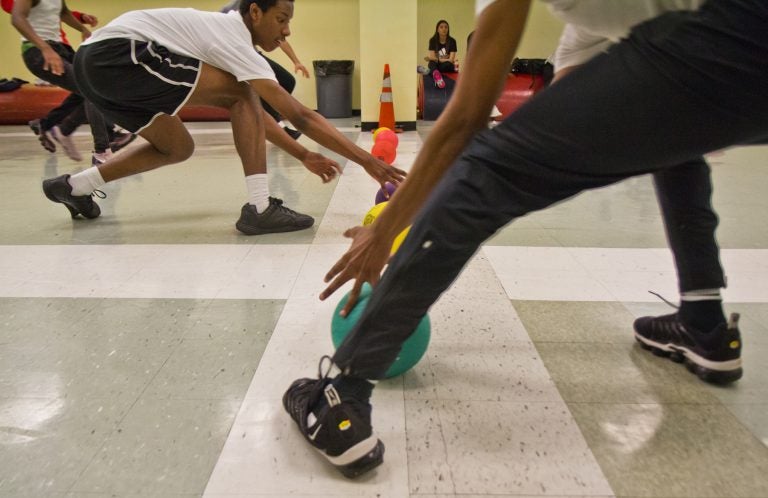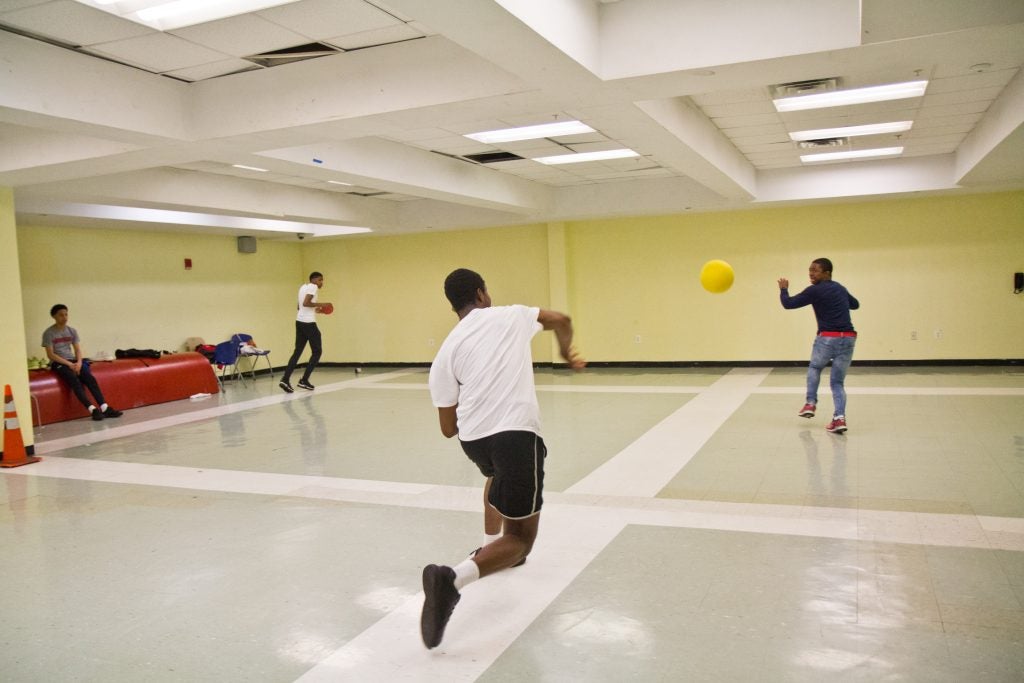Fixing the nightmare gym class can be for some kids
TV and movies represent everything that’s wrong about physical education. Some teachers are working to change that.
Listen 06:49
Students at Philadelphia’s Constitution High School face off during dodgeball. (Kimberly Paynter/WHYY)
When Aisha Sultan was in school, she hated gym class, and she particularly disliked running outside in the Texas heat.
“It was such a forced activity, and sometimes we had to do it as punishment,” Sultan said. “If somebody had done something wrong, or the teacher was just like in a bad mood, we would be out there running laps.”
“I was never good at any sports, and it led me to believe that I was not athletic and terrible at physical activity.”
But that’s not the case. Sultan, now a columnist based at the St. Louis Post-Dispatch, has always been physically active. She likes hiking, and took dance and cardio classes in college. And in 2014, almost 20 years after her last gym class, she ran outside — she ran a marathon.
“But you would never have known that, if you had seen me in my misery in gym class,” Sultan said.
Many people share that misery:
Gymnastics. Teacher says to do a cartwheel. I give it my all. Teacher announces: Leigh just demonstrated a GREAT baby cartwheel
— Leigh Goldenberg 01-10 (@leighalice) June 7, 2019
I’m maybe 12. Mad awkward with a crush on Steven Martínez, class heartthrob. Gym teacher calls Dodge ball, where I struggle to get his attention but not get tagged. Steven Martínez clocks me straight in the face and my nose starts bleeding. Kids laugh and I learn: love hurts.
— Helen Ubiñas (@NotesFromHeL) June 7, 2019
And the effects of gym class can stay with you.
A study of more than a thousand people across the United States found that bad memories of gym class, especially memories of not being chosen first for teams, could be linked to being less physically active as adults.
When a grant program in Texas mandated daily physical education classes for some middle school students, class attendance actually went down.
Now, PE teachers are trying to change gym class, to make it more inclusive.
One big problem is that gym class sometimes reinforces existing differences: Students who start out fit get better, and those who don’t get left behind.
Tymir Felton, a recent graduate of Constitution High School in Philadelphia, likes gym class, but he’s also a self-proclaimed “exercise freak” who plays football, basketball, volleyball, runs track and cross country, and works out five days a week.
“I like staying fit, staying in shape, gym is how I do that when I don’t get a chance to work out.”
In contrast, Andrew Rowan, who just graduated from Moorestown Friends School in New Jersey, says he’s not the most athletic student. “In my class you have a wide variety of athletic ability. So if the unit we’re playing is basketball, you’ve got these star basketball players who are actually on the high school varsity basketball team, and then … me and some of my friends who are … struggling to not get knocked over as people are dunking on the basket.”

Robert Moore, a PE teacher at Constitution High School, knows this, so sometimes he lets the students choose what they want to do as long as they fulfill the goal of the class. If it’s cardio day, he said, students can play dodgeball, go up and down the steps from the basement to the sixth floor, or jump rope.
“As long as you’re doing something active,” Moore said, “you get an ‘A’ for the day.”
And he’s open to taking a backseat and letting a student lead the class, like one student who is experienced at yoga.
“We co-instruct classes sometimes,” Moore said. “I’ve taken yoga a few times, I’m not terrible at it, but she has all the stretches and all the poses, and I let her kind of dictate and I just follow along as the teacher, like telling kids, making sure the kids are doing it and the rest of the class jumps in.”
The whole point of gym class, he said, is for everyone to be active, in high school, college, and beyond.
Michelle Carter is the senior program manager at SHAPE America, a professional group for health and PE teachers. Her organization is working to reinvent gym class nationally.
She was a PE teacher for six years, and she knows it will not be easy to change people’s minds.
“I’d meet up with friends and we would do go out for dinner or happy hour, and I’d meet other young professionals, and we’re sharing, ‘Oh, what do you do?’ And I would tell them that I’m a PE teacher, and I think the two most common things that I did hear was: ‘Oh, I couldn’t stand PE,’ or they would ask me, ‘Oh, do you still play dodgeball?’”
Carter said any high school PE teacher in a TV show or movie is an example of what not to do.
“That’s old school PE that we are trying really hard to change,” Carter said.
There are no federally mandated standards for physical education class, but she said most states adopt standards from her organization or use something that’s very similar, with these basic principles:
- Students learn at their level: Star volleyball players can play volleyball, but students who are new to the sport should be allowed to play with a lower net or play two-on-two until they master the basics.
- Goals are different across different grades:
- Elementary school is for basic skills, like kicking and throwing.
- Middle school is for what are called “invasion games,” team sports that involve moving into an opposing area to score, like soccer, basketball, and hockey.
- High school is for activities that students can do for life, like tennis, badminton, or fitness activities.
Plus, Carter said, students should not have to stress about where they stand in the social hierarchy — so students don’t get to pick the teams. Instead, teachers can form teams based on what color shirts people are wearing, people’s birthdays, or the first letter of names.
“So it’s not friends trying to get with friends, or people feeling left out, but it’s something that’s more random and allows for different people to work together.”
WHYY is your source for fact-based, in-depth journalism and information. As a nonprofit organization, we rely on financial support from readers like you. Please give today.







